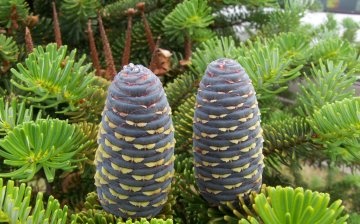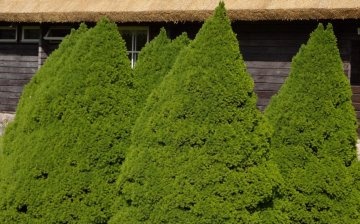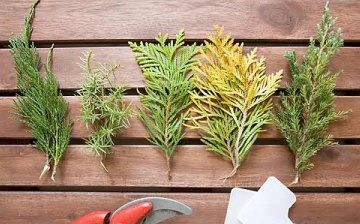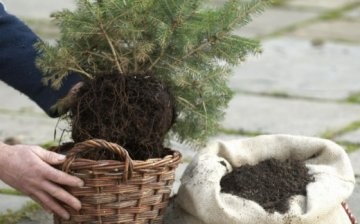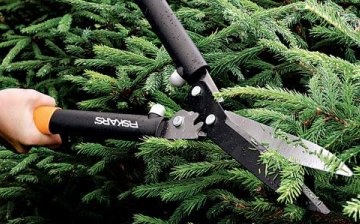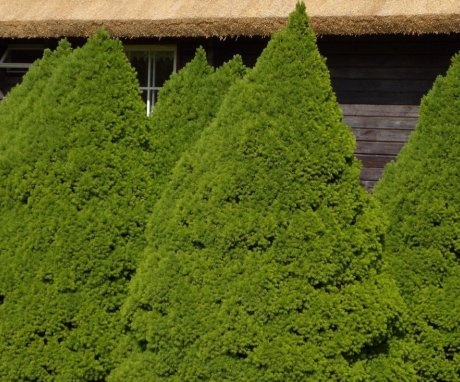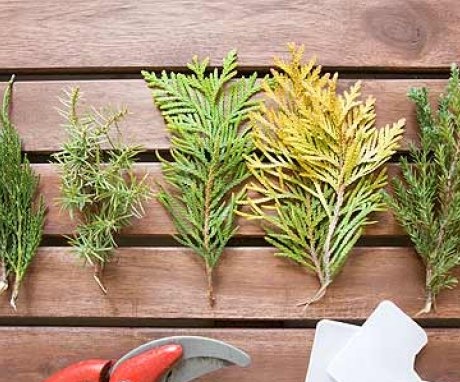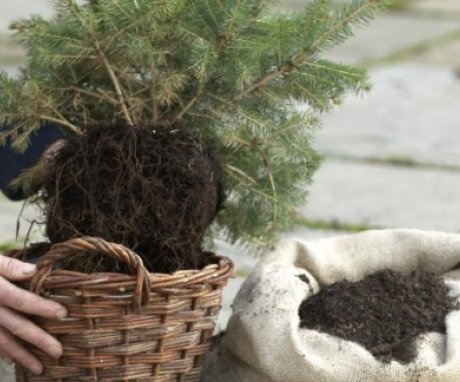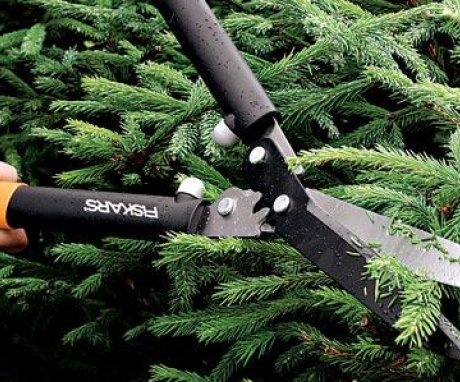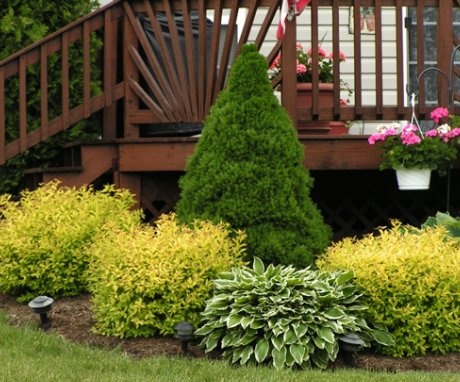The most popular varieties of spruce
In our Russian forests, spruce is often found, but not all of its varieties can be planted on the site: they require a lot of space and special conditions for growth. Breeders have bred many types of dwarf spruce, which helps to engage in their breeding, growing in the garden.
Thanks to its dense crown, the spruce tree is suitable for revitalizing the site of a country house. If in the wild it is forced to adapt, then, having taken care of a spruce, you need to know what conditions it needs to stay healthy, how to make it a decoration of the garden.
Content::
- Decorative varieties of spruce, their description
- Breeding methods for conifers
- Terms and rules for planting spruce on the site
- Recommendations for tree care
- The use of conifers in landscape design
Decorative varieties of spruce, their description
Spruce - one of the most beautiful coniferous trees, which is suitable for growing in any climatic zone. Plant breeding pleases not only with the size of the tree, intricate crown shapes, but also with the color of the needles:
- Dwarf tree species are inherent in height from one meter to three. Such a variety is only proud of its unusual crown. There are columnar, pyramidal, spherical, conical forms. Nidiformis with a flat bushy crown is suitable for small areas. And the balls of Nana's Christmas tree with almost black needles look quite original on green lawns... Cone-like spruce from Canada - Konica has thin branches with light green needles tightly pressed against them.
- The blue breed of firs has always been distinguished by nobility of color and attractiveness. It is not for nothing that these types of trees are found in the central squares of many cities. The best decoration of the garden would be the Montgomery variety, which reaches a height of less than two meters, has a crown that looks like a flattened pillow. A tree with bluish-gray needles - Valburn - withstands frosts. Varieties of thorny spruce can have a conical shape, silvery-blue color of needles. For the preservation of the crown, their first years of life are tied up.
- Horizontally growing or creeping species are especially attractive to landscape designers. Of these, the most common variety is Reflex, the stems of which spread picturesquely along the ground. These types of fir trees also surprise with the color of the needles: from green-yellow to blue, silvery tones.
Which tree should be planted on the site depends on its size, on where the spruce will grow, in the neighborhood with which plants.
Breeding methods for conifers
You can propagate a coniferous tree seeds and cuttings... And for decorative rocks there is a method vaccinations... The first method is the longest, requiring diligence and attention:
- Spruce seeds can be purchased at the store or collected by yourself after the cones are fully ripe at the end of October.
- Two to three months before sowing, they are removed from the cones stored in a cool dry basement.
- Nuts are dipped in a weak solution of potassium permanganate for a day.
- Prepared containers are filled with sand, moisturizing it well, and placed in a cold place.
- Seeds are sown in mid-April. For them, a thin layer of sawdust is placed in a container with sand.Above - spruce nuts, and on them there are also coniferous sawdust.
- The soil for seedlings should always be moist, they need to be fed mulleindiluted in water in a ratio of 1: 5.
You can immediately place the seeds in open ground, arranging additional protection from the wind from a frame built of twigs and covered with a thin cotton fabric from the sun's rays.
For propagation, cuttings of conifers are harvested in early spring, then they can take root this year. But sometimes you can cook them in winter, then the seedlings will take root at home. Cuttings are prepared from lateral branches that already have lignification of the trunk. Cut them off with a heel, using scissors or pruning shears. Needles are removed from the bottom, as they will interfere with the development of roots.
Before planting, do not forget to lower the branches into Epin's solution for twelve hours. It is also necessary to prepare sphagnum moss, pre-soaked in clean water, then distributing it over a polyethylene tape. Each stalk is dipped into a growth stimulator of the Kornevin type, then the lower parts are distributed over the moss. Having rolled the tape into a roll, this bunch of conifers is placed in a cool place: a pantry, a veranda, between the windows, sheltered from sunlight.
By the spring, the Christmas trees will give the first roots, which must be planted in open ground in a permanent place in April.
Cuttings from blue, silver varieties can be grafted onto five-year-old seedlings. The graft is usually prepared in winter or early spring before bud break. Usually, with this method, the cut of the cutting is combined with an incision in the rootstock. The vaccination site must be tied with twine, filled with pitch. With this method of reproduction, the care of the seedling is more thorough.
An easy, low-cost method of breeding plant varieties is cuttings, which are suitable for breeding varieties. By spreading with seeds, you can preserve the species qualities, properties of the coniferous tree.
Terms and rules for planting spruce on the site
The best month for planting spruce trees is May, when a wave of night frosts will pass. Autumn planting in late August - early September is also suitable for them. It is mandatory for planting to prepare a hole for a plant, into which a drainage layer consisting of expanded clay or crushed stone is poured, and nitroammofosk mixed with soil. For trees, a substrate from the same amount of sod soil, a mixture of leaves, to which half the amount of sand and peat is added, is suitable for development.
When planting a seedling, you need to pay attention to the fact that the root collar is not buried or exposed.
The distance between young trees should reach two to three meters; for ground cover species, one meter will be enough. A layer of peat or coniferous mulch is poured around the spruce trunk sawdust six to eight centimeters thick. Decorate trees and circles of colored gravel, pebbles. The planting process is completed with abundant watering of the seedlings.
For spruce trees, it is necessary to choose places for constant growth, both sunny and partial shade. If the groundwater is especially close, then this is especially good for the spruce, since its roots are almost on the surface of the earth.
Recommendations for tree care
The basis for caring for spruce trees includes several points:
- The moisture of the soil under the tree is the main thing during the growth of the coniferous tree. If a clod of earth taken next to the plant crumbles, then it's time to water it. For an adult ate up to twelve liters of water a week is required, for young people - less, but with an increase in frequency glaze.
- Young seedlings need annual feeding mullein (five hundred grams per one square meter), superphosphate (thirty grams), potassium nitrate (fifteen grams). Fertilize, evenly scattering the nutritious mass on the ground, then covering it with a hoe to a shallow depth of eight to ten centimeters. Mature trees ask for top dressing in the spring in the form of universal complexes.
- Loosening and weeding of spruce plantings must be carried out carefully so as not to damage the roots of the plant.
- In spring they produce pruning oil when broken, dry, diseased twigs are removed. And for crown formation this process is simply necessary, and here a person's imagination knows no bounds. When two tops appear, one must be removed.
- Although many varieties of trees are not afraid of frost, it is better to cover young plants with spruce branches, kraft paper, non-woven material. Also, covering the seedlings from the sun plays an important role, and natural fabrics are needed here.
For the full development of conifers, it is necessary to choose the right place on the site, take care of the comfort conditions for them.
The use of conifers in landscape design
For the formation of the style of a suburban area, spruce of different types is perfect. In such a form as rockery, you can combine the beauty of natural stone and spruce trees. The English style is characterized by the use of evergreen conifers with different crown shapes and heights. The Japanese garden type requires a combination of dwarf varieties with large boulders. Uneven surface areas are particularly suitable for such compositions. Ground cover varieties of spruce, decorated with colored gravel or river pebbles, feel comfortable among the stones.
Spruces in the form of hedge.
If they are high in height, then they will successfully replace an impregnable fence, and miniature options will make the garden cozy, natural. Thanks to the spruce trees, you can actively engage in the art of topiary, which came to us from overseas. On the basis of ready-made metal frames, various green figures of humans, animals, birds, and various objects will appear in the garden.
Pyramids, cones, balls of fir trees will create a classic garden style. Ordinary, prickly tree varieties are especially suitable for interesting compositional solutions of topiary. Spruces of different sizes look great in single plantings. They can be a backdrop for decorative perennials and annuals, as well as decorate a recreation area. In the well-thought-out design of the site, there will always be a place for fluffy spruce trees.
More information can be found in the video:



